In archaeology there are several methods of collecting and processing data and a lot of them can be performed in the lab. Sometimes, however, there is a need to do what is called flotation (click on this link to see a short video of flotation using a commercially-made tank); this is when a sample is put into a deep screen which sits inside a tank that is being pumped with water from below the screen.
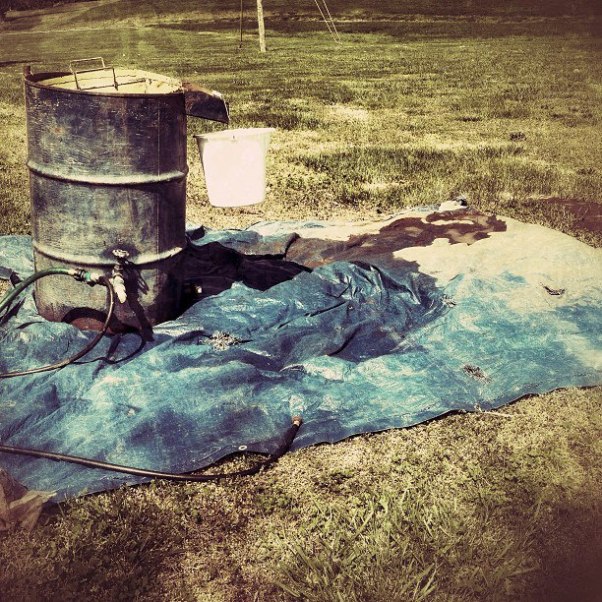
Flotation tank set-up (photo by Abigail Hyndman).
As the water flows, the sample gets stirred and swished by an archaeologist
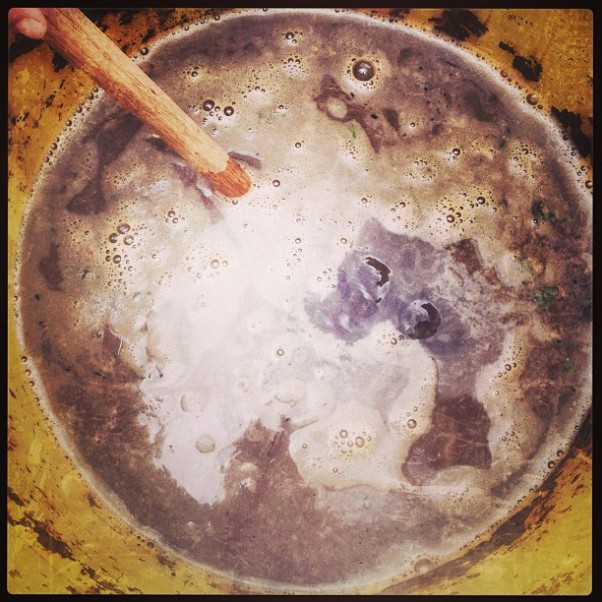
Archaeology stew (photo by Abigail Hyndman).
and the light “fraction” (artifacts and particles that float) floats to the top of the screen and spills out a spout onto a smaller screen along with the water that has overflowed.

Water pouring out of spout (photo by Abigail Hyndman).
This leaves us with all of the tiny artifacts on one screen (light fraction), and all the larger and heavier artifacts still in the big screen (heavy fraction). The reason why we do this process is so that we can be sure that we’re seeing things as small as seeds or tiny bits of charcoal within a sample. These things are often washed or screened away without the use of the flotation tank.
Right now, MTSU Anthropology majors Mimi Glass and I (Abigail) are working on using this method on samples from last summer’s excavations at Site 40DV7. When we started there were over fifty samples that needed to be processed and now we are close to being finished. Within these samples we’ve seen a lot of charcoal, tiny pieces of shell, small lithics, and even some small bone fragments. It’s dirty work but very rewarding as you watch a big bag of dirt turn into small archaeological finds that will yield big data!
Guest post by Abigail Hyndman
(Many thanks to the Tennessee Division of Archaeology for allowing us to use their flotation equipment!)
As a graduate of two Florida institutions of higher education holding a BA, MA, and PhD in Anthropology, the grassroots This Is Anthropology movement caught my attention early on. I congratulate Jason Miller, Charlotte Noble, and Janelle Christensen for starting this project, but more importantly for turning passionate disbelief and at times, I imagine, anger, into something positive and educational. I am also pleased that the American Anthropological Association understands the importance of sharing the good work of Anthropologists to a public that does not always know what Anthropologists “do,” much less why Anthropology is an integral part of our society.
If you are an Anthropologist, please add your profile to the “Find an Anthropologist” map. Help spread the word via Twitter #thisisanthro.
The website is quickly becoming the go-to place for information related to the field of Anthropology. If you are interested in becoming an Anthropologist, or just want to read more about the many different ways we practice Anthropology, you can search the interactive Google map of Anthropologists and projects from around the world, read about the skills necessary to perform fieldwork, the kinds of jobs we are hired for, and find advice on beginning a career in Anthropology.
With that being said, the blog post below is re-posted from Neuroanthropology on the PLOS Blogroll.
This Is Anthropology.
Today was our last day in the field. It was a good day. As I watched the wheelbarrows, shovels, and tractor bucket swiftly carry the dirt back to the excavation units I felt happy and satisfied with our work of the preceding seven weeks. We accomplished what we set out to do. The fieldwork could not have gone smoother. We met some very generous and kind people along the way and caught up with old friends. We are left with a load of data to analyze, sort through, and ponder. What more could any scientist ask for?
I think some of the students were a bit sad. I remember that feeling after my first field school. You grow close to a group of people, you get used to seeing them everyday, and then bam! you are left with a lot of free time as everyone parts ways. Most, if not all, will renew these friendships in late August when the fall semester starts up at MTSU. This group of students was wonderful. I told them I don’t think I have ever worked with a more agreeable bunch and I would be pleased to work with all of them again in the future. That says a lot!
We close this week with some fun facts and statistics from this season (but be sure to check back in July — we will be blogging from the lab):
- We hand excavated 33.435 cubic meters of dirt and rock from 109 bucket auger tests, 8 excavation units, and 2 column samples.
- We recorded over 245 field specimens.
- We used just about 250 50-lb feed bags for sample collection.
- We hand excavated the deepest auger test ever recorded for the Cumberland River (it’s over 9 meters deep!).
- On June 1, it was cold enough that we had to wear jackets the entire day.
- On June 28 it reached a record 108 ° F (without the heat index)!
- We slathered and sprayed on a collective 19 tubes and 16 cans of sunscreen, and 18 cans of bug spray.
- At least 17 tubes of lip balm were on site at any given time.
- Our water coolers hosted a total of 90 bags of ice over the 32 days we were on-site.
- We consumed a cumulative 90 Sonic large iced teas; 30 Red Bulls; 17 microbrew sodas; over 200 quarts of Gatorade/Powerade/Vitamin Water; and around 450 gallons of water.
- We commuted a total of 3,150 miles from campus to the site over the 7 weeks.
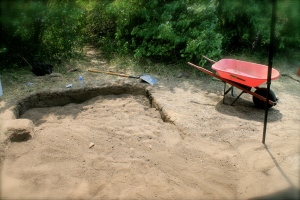
Nearly there
Tomorrow….we picnic!
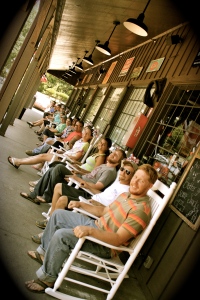
MCAP Field School 2012 enjoys the front porch at Cracker Barrel post-backfilling.
Today we began the several-day long process of closing up the site. We have some documentation to finish, but we now have three units officially backfilled. Backfilling is always bittersweet.
You spend weeks carefully excavating a square area in very small increments. . .
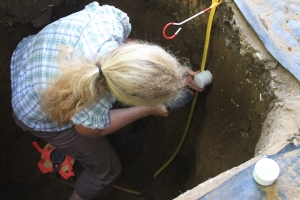
Dr. Peres collecting some final samples before the unit is backfilled.
only to throw all the dirt back in in a matter of an hour or so.
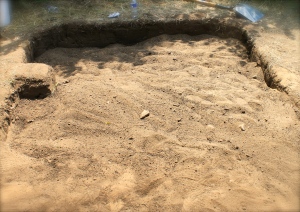
Backfilling in progress.
There is much more of this in our very near future! We are looking forward to slightly cooler temps tomorrow (high of 87 instead of 97) and the closing up of several more units.
In the meantime, here is a honey bee doing its thing in my backyard over the weekend.

Bee on sunflower.
There are only 4 field days left to our field school, but that doesn’t mean we get to sit in the shade and eat ice cream for the next week! This week we moved a lot of dirt (per usual), learned some new tricks (like the GPR), and began the final stages of full documentation — photos, mapping (lots of mapping), sediment profiles, radiocarbon samples, column sampling, and the like.
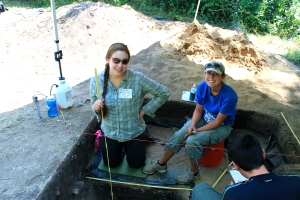
MCAP Field School students Wesley Vanosdall, Kate McKinney, and Kyle Deitrick have fun profile mapping their excavated unit.
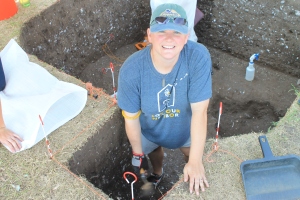
MCAP Field School student Pam Hoffman excavates a 50×50 cm column sample.
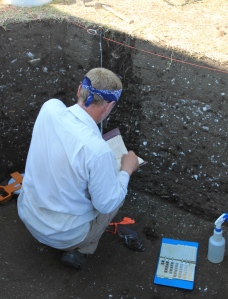
MCAP Geoarchaeologist Ryan Robinson describes sediment profiles from a finished excavation unit.
We also had several visitors from MTSU today. Dr. Jackie Eller, chair of the Department of Sociology & Anthropology; Dr. Kevin Smith, Director of the Anthropology Program and Senior Advisor to the project; Georgia Dennis, Anthropology Alumnus and current Honors College staff and friend Judy.
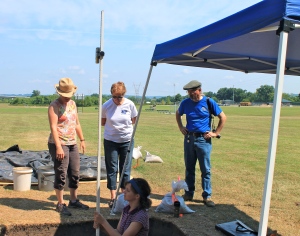
Dr. Peres explains our excavation strategy and findings to Drs. Eller and Smith.
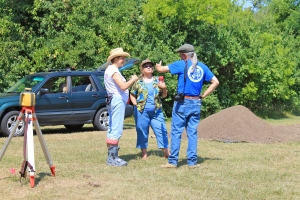
MTSU visitors Georgia, Judy, and Dr. Smith.
Monday starts our final week of the 2012 MCAP Field School. We will finish the last bit of our excavations and data recordation, have a practical skills test for the students, backfill the units, and celebrate our accomplishments with a picnic!
— post by Dr. Tanya Peres
In a perfect world all archaeological projects would proceed in textbook fashion with full funding. My ideal archaeological project would include a team of experienced specialists working together on the research design, fieldwork, lab analysis, and interpretations. I would say that this years MCAP Field School has come pretty close to that ideal — minus the full funding!
One of the important parts of our project was to conduct a geophysical survey to determine where we would locate our excavation units. Remote sensing is a term that covers a variety of techniques and applications of non-invasive site survey. The types of remote sensing we built into our research plan are all sub-surface and basically act like a CAT scan of the earth, allowing us to see anomalies below ground without digging.
In my perfect archaeological world, remote sensing activities would take place before any actual digging occurred. As life is never perfect, and rarely goes exactly according to plan, MCAP unfortunately did not receive the grant funds we applied for. However, we have been most fortunate to have generous colleagues that have donated their time, equipment, and in the case of remote-sensing, the cultural resources management firm Brockington Cultural Resources Consulting, sent two archaeologists and their GPR know-how! The archaeologists at Brockington felt this site is so important and well preserved, and GPR survey has rarely been done this type of site, that they donated the archaeologists’ time and effort to our cause. We are so excited and thankful for their generosity and expertise.
Ground-Penetrating Radar (GPR) allows us to “see” anomalies under-ground and then to ground-truth them. Since we conducted this survey this week, at the end of our current field season, we will do a few preliminary tests on some of the “hot spots.” If we are able to return to this site in the future, we will use these data to inform where our excavations will go.
The preliminary “in-the-field” results are exciting and have piqued my curiosity. The other great think about this survey was the chance for the MTSU MCAP Field School students to be involved. Dave Baluha and Niki Mills were excellent teachers — the students thank them for the experience and opportunity! The archaeologists with Brockington will analyze the data and put it into map form. We will then discuss the implications of the data and hopefully present our findings at a regional professional archaeology conference in the fall and publish it in a professional journal. Stay tuned for more information on the results!
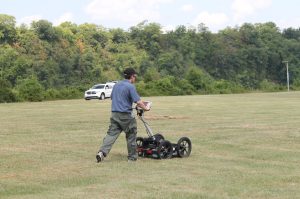
MTSU MCAP Field School student, Kyle Deitrick, operates the GPR.
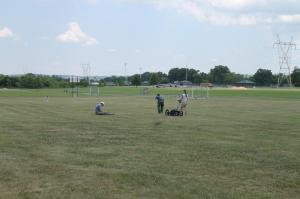
MTSU MCAP Field School students Kyle Deitrick and Cori Crenshaw get a lesson in GPR survey from Dave Baluha, Brockington and Associates Archaeologist.
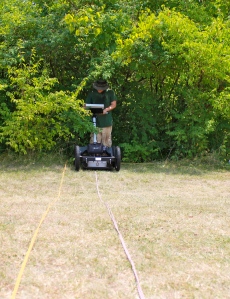
MCAP Field School student Sean McKeighen operates the GPR equipment.
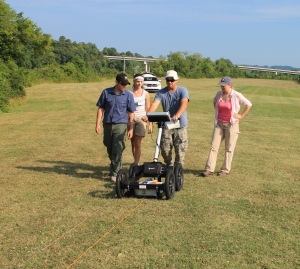
Brockington Archaeologists Dave Baluha and Niki Mills show the field school students how to operate the GPR equipment.
Today is the summer solstice which marks the longest day of the year. It was also the hottest day of our field season — topping out at a blazing 98°F. We are starting the slow process of finishing excavations in our units, bisecting and excavating features, profile mapping finished units, and working on a GPR survey (to be discussed in a separate post). We are all excited to be this far along in the fieldwork, but surprised at how fast it has gone. Today we had several visitors to the site. Mike Moore and Aaron Deter-Wolf, Tennessee Division of Archaeology, came by to check on our progress. Dr. Derek Frisby, MTSU History Professor and MCAP Historian, spent the afternoon learning about our digs, talking to the students about their experience on-site, and telling me about the preliminary findings of his historical research on the property.
Photo round-up of some our daily activities.

MCAP Field Assistant, Kelly Ledford, deep in a 1 x1 m unit.

Field School Student, JoBeth Simon, helps to run the GPR unit.

Field School student, Erin Floyd, was in charge of the Field Specimen log on Tuesday. We all agree this is the toughest job on-site.

Field School students, Tee Gildemeister and Sean McKeighen, work in Unit 9. Blake Meador examines the backdirt.
Apologies for the lapse in posts. As I feared, 16+ hour days are starting to take their toll in Week 5. Lack of energy to blog is the result. As we near the end of the field season (2 more weeks to go after this week), the pace of excavations picks up and we have many more tasks to complete before we close down the site. Archaeologists are nothing if not avid note-takers, thus we have lots of in-the-field data to record via field notes, field forms, photographs, and maps. The students are excited to learn all of the aspects of fieldwork during this “apprentice-ship” phase.
The weather has been more than fantastic the entire season, and we have been fortunate to not have had a rain day yet. This week started on the wet side, and Monday promised to be a day of off-and-on rain. I was not willing to take a chance on the units getting wet/muddy, paperwork and equipment getting soaked, etc. I sent the word out on Sunday night that we would meet at the lab for a much-needed day of organization and artifact washing.
Monday was a complete success! Not only did we organize the archaeology teaching lab, but we were able to tackle our storage lab and the research lab. The students caught on to the concept of artifact washing quickly (which takes a bit of skill) and powered through a third of the artifact bags!
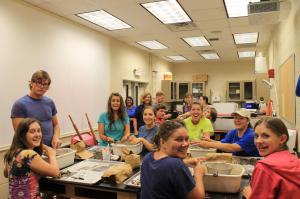
Washing artifacts in the MTSU Archaeology Teaching lab.
Tuesday we were back in the field continuing excavation of our units. Erin Floyd and Pam Hoffman completed excavation of Unit 3. We still have to map the wall profiles, but once that is done we can focus their attention and energies elsewhere. Every day we gather more information that will help us better understand the people that lived along the Cumberland River so long ago.
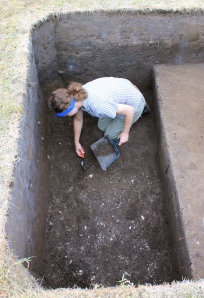
Erin working diligently to expose the top of the shell deposits.
Today (Wednesday) was more of the same. Schnitting, screening, photos, etc. A sense of urgency is starting to kick in as we all realize we have fewer and fewer days left on site. Kelly and Mimi are working in a 1 x 1 m column within Unit 1 to explore the dense shell deposits.
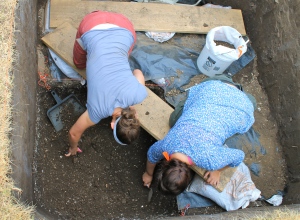
Mimi (left) and Kelly (right) excavate the shell deposits with trowels. To protect the walls and floor of the 1 x 1 column, they are perched on a 2 x 10 board.
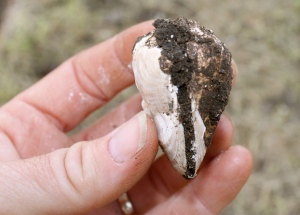
Articulated/paired freshwater mussel identified during excavations.

Dewberries on the edge of the field.
Week 4 was a full week of excavating, lectures, and visitors. Everyone is into the groove of the daily routine. As the professor, it is nice to step back at different times during the day and watch the students going about their business as if they have been doing this forever. I have to admit, it is a relief not to hear “Dr. Peres…where is the (clipboard, stadia rod, line level, fill-in-the-blank)” every five minutes. They probably know which tub or box these things are in better than I do now!
Here are some highlights from the second half of Week 4:
- The shell deposits were completely exposed in the floor of Unit 1 at a depth of 1 meter. This unit will now continue as a 1 x1 meter column through the shell deposits. Kelly Ledford has taken over this excavation as it is part of her URECA Scholar grant-funded research. Mimi Glass is working with her on this. They are excavating the column in 5 cm-thick levels and keeping a 100% sample.
- Erin Floyd and Pam Hoffman continued excavating Unit 3 as a 1 x 2 meter unit. The top of the shell-bearing deposits were exposed at just over 1 meter in depth. Erin and Pam will finish exposing them early next week and will photo, map, and record elevations on these deposits.
- Unit 6 (caddy corner to Unit 1) is quickly getting deeper. There are four students working this unit so that there are always two people schnitting and two people screening. They should hopefully be at the level of the shell early next week.
- The team at Unit 7 (Kyle, Kate, and Wesley) continue their excavations, but are slowed by the amount of FCR and shell they have to pick out of the screen. Not a bad reason to go slow, I say!
- Callie, Cori, and Karen are diligently working at Unit 8. They have a similar issue as Unit 7, with lots of FCR and shell. On Friday we set up a second screen at their unit to speed up the work.
- I am pleased to report that Units 4 (Blake, Cat, and Madison) and 5 (Arthur and Tee) were closed up late in Week 4. The artifact content dropped off, and a number of soil probes and a bucket auger test showed there was no shell in either of these units. I decided to terminate excavation of them so we could focus our efforts on other parts of the site. Both teams had to spend some time cleaning the floors and walls for photos and maps. Ryan took soil samples and completed a soil profile/sediment description for Unit 5. By the end of Friday the entire class was involved in backfilling both of these units. It is always a good feeling to close up a unit once it has answered your question (and the answer is…..).
- Visitors: Late Wednesday afternoon we had a brief visit by Mr. Vince Durnan, Director of USN. On Thursday Mr. Steve Smail, High School Geology teacher at USN stopped by. We enjoy sharing our work and what we are finding, especially when others are as interested as we are.
- Lecture: On Thursday the majority of the class was able to attend a free public lecture on Tattoo Archaeology given by Aaron Deter-Wolf at Bells Bend Outdoor Center. It was a fun outing as we were able to go out to dinner before the lecture. It was a late night, but definitely enjoyed by all that were able to attend.
The forecast for next week is calling for 60-70% chances of rain. We’ve beat the odds so far this field season. After four weeks, we have not had one single rain day. I don’t know if our luck will hold up, but I am definitely okay if we spend a day or two in the lab. We have some organizational things to deal with, and oh yeah, lots of FCR that needs to be washed! (Any volunteers?)
— post by Abigail Hyndman and Dr. Peres
Today was a great day! The sun was been out but not nearly as hot as the past few weeks and a cool breeze blew in from the northwest. Everyone was ready to work.
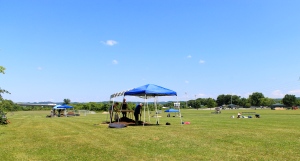
A gorgeous June day! Too bad you can’t see the breeze in the picture.
Unit 6 is the one that I (Abigail) have been screening for and it has been a love/hate relationship from the beginning. While in Units 1 and 3, the soil is very wet and clay-like, Unit 6 is hard and compacted.
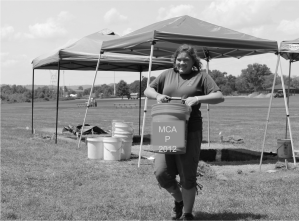
Abigail Hyndman carrying a bucket of dirt to the screening station.
While easy to screen, it is not at all easy to dig at this point. We are still in the “plow zone” (the upper sediments disturbed by mechanized agriculture in historic and modern times), which seems to never end. We are excited and ready to see what we recover in the coming days.
In the other units, it is business as usual. We have reached the top of the shell deposits in Unit 1.
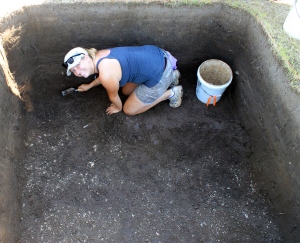
Top of shell deposits exposed in Unit 1, approximately 95-100 cm deep.
Today JoBeth, Mimi, and Dr. Peres continued troweling off the last few centimeters of dense dark midden trying to determine where the shell stops within the unit. It is slow work, but the effort is rewarded by interesting finds and the joy of watching each other get in and out of this, very deep, unit.
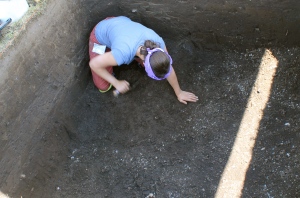
Mimi trowels herself into a corner uncovering the top of the shell deposits.
Today two interesting artifacts turned up in this deep midden layer above the shell deposits. On the left is a possible sandstone pendant or gorget (broken of course). On the right is a piece of crinoid fossil, which may or may not have been used as a bead or charm. We will need to analyze it further under a microscope to see if there are any indications of use wear around the center opening.
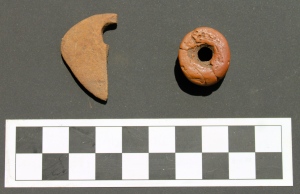
Possible sandstone pendant (on the left) and crinoid fossil (right) from the deep midden.
Field Assistant, Kelly Ledford, leads the team working in nearby Unit 3.
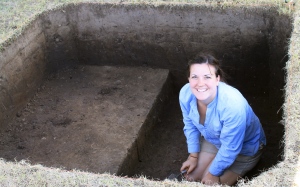
Field Assistant, Kelly Ledford, continues excavation of Unit 3.
This unit started as a 2 x 2 m, and is now continuing excavation as a 1 x 2 m unit. We did this knowing there are no shell deposits in the eastern half of the unit — working on only the western portion will save us time. Kelly and her team (Pam Hoffman and Erin Floyd) will continue to excavate this until they reach the top of the shell deposits. We anticipate this to be in the next 20 cm or so. Then they will excavate a 1 m x 1 m column sample and bag every level (the same will be done for every unit that reaches the shell) — thus we will have a 100% sample of the shell deposits.
The team working in Unit 7, located in the southernmost extent of the site no covered by trees and undergrowth, continues to excavate through mixed deposits of gravel/fill, historic trash (glass, metal cans, etc.), and prehistoric artifacts (pieces of rocks, a broken projectile point). We hope they will be through this debris tomorrow morning and into intact deposits. You might wonder how all these things got so mixed up. Dr. Peres thinks that some of this is junk left behind by a previous tenant (when it was a working farm), some is mixed up from plowing, and some is debris left behind when the flood waters receded in May 2010.
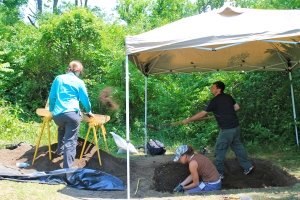
MTSU Anthropology majors (L to R): Wesley Vanosdall, Kate MicKinney, and Kyle Deitrick. Kyle perfects his shovel toss, Kate cleans up the unit walls, and Wesley screens for artifacts.
Along with continuing excavations in the units, Ryan Robinson has returned to do continue his deep bucket auger testing program. With the assistance of two students, he is doing some additional deep auger tests.
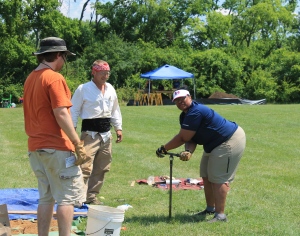
Ryan Robinson instructs field school students Sean McKeighen and Karen Patterson in the fine art of augering and describing soils.
They encountered the expected shell deposits at about 120 cmbs (which is what we expected). Under this there is an interesting sand to soil composition, with the two alternating to a depth of over 5 meters.
We are almost to the halfway point of the field season and there is a lot more information left to recover so back to the trenches…or units!


































